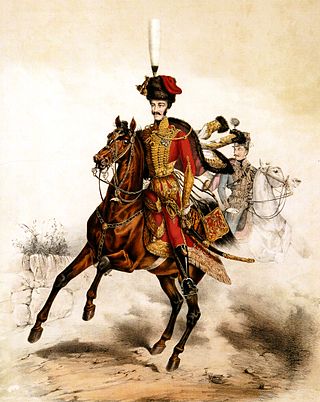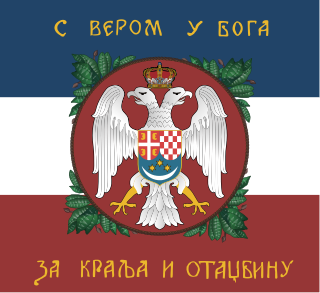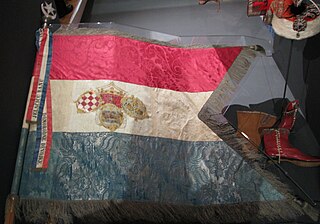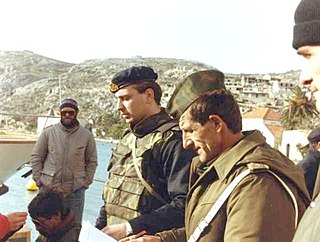
A hussar was a member of a class of light cavalry, originally from the Kingdom of Hungary during the 15th and 16th centuries. The title and distinctive dress of these horsemen were subsequently widely adopted by light cavalry regiments in European armies during the late 17th and 18th centuries. By the 19th century, hussars were wearing jackets decorated with braid plus shako or busby fur hats and had developed a romanticized image of being dashing and adventurous.

Operation Storm was the last major battle of the Croatian War of Independence and a major factor in the outcome of the Bosnian War. It was a decisive victory for the Croatian Army (HV), which attacked across a 630-kilometre (390 mi) front against the self-declared proto-state Republic of Serbian Krajina (RSK), and a strategic victory for the Army of the Republic of Bosnia and Herzegovina (ARBiH). The HV was supported by the Croatian special police advancing from the Velebit Mountain, and the ARBiH located in the Bihać pocket, in the Army of the Republic of Serbian Krajina's (ARSK) rear. The battle, launched to restore Croatian control of 10,400 square kilometres of territory, representing 18.4% of the territory it claimed, and Bosniak control of Western Bosnia, was the largest European land battle since World War II. Operation Storm commenced at dawn on 4 August 1995 and was declared complete on the evening of 7 August, despite significant mopping-up operations against pockets of resistance lasting until 14 August.

The Military Frontier was a borderland of the Habsburg monarchy and later the Austrian and Austro-Hungarian Empire. It acted as the cordon sanitaire against incursions from the Ottoman Empire.

Karlovac is a city in central Croatia. In the 2021 census, its population was 49,377.

Chasseur, a French term for "hunter", is the designation given to certain regiments of French and Belgian light infantry or light cavalry to denote troops trained for rapid action.

Trenck's Pandurs were a light infantry unit of the Habsburg monarchy that was raised by Baron Franz von der Trenck under a charter issued by Maria Theresa of Austria in 1741. The unit was largely composed of volunteers from the Kingdom of Slavonia and Slavonian Military Frontier, and named after security guards otherwise employed to maintain public order. The Pandurs were presented to the empress in May 1741 with the unit's military band earning them a claim of pioneering martial music in Europe. The Pandurs did not use uniforms and had an overall Ottoman appearance. The original organization of the unit was retained until 1745, when it transformed into a regiment. Trenck was relieved of command in 1746 and imprisoned in Spielberg Castle, where he died in 1749. The unit ultimately transformed into the 53rd Infantry Regiment, headquartered in Zagreb, until it was disbanded in 1919. The regiment's commemorative medals bear Trenck's image wearing Pandur attire.

The Croatian Army is the land force branch of the Croatian Armed Forces. It is numerically the largest of the three branches of the Croatian Armed Forces. The HKoV is the main force for the defense of the country against external threats, and in addition to the task of defending the Republic of Croatia, the HKoV also has the task of participating in peace support operations and humanitarian operations as part of international forces, as well as the task of preventing and eliminating the consequences of emergency situations in the country caused by natural and technical accidents and disasters.
The military history of Croatia encompasses wars, battles and all military actions fought on the territory of modern Croatia and the military history of the Croat people regardless of political geography.

In contemporary geography, the terms Central Croatia and Mountainous Croatia are used to describe most of the area sometimes historically known as Croatia or Croatia proper, one of the four historical regions of the Republic of Croatia, together with Dalmatia, Istria, and Slavonia. It is located between Slavonia in the east, the Adriatic Sea in the west, and Dalmatia to the south. The region is not officially defined, and its borders and extent are described differently by various sources. The term Central Croatia refers to the northeastern part, and the term Mountainous Croatia refers to the southwestern part of the territory; the far western part is known as the Croatian Littoral; likewise the terms 'Zagreb macroregion' and 'Rijeka macroregion' can be used instead. Central Croatia is the most significant economic area of the country, contributing well over 50% of Croatia's gross domestic product. The capital of the Republic of Croatia, Zagreb, is the largest city and most important economic centre in Central Croatia.

The uprising of 1821 was a social and political rebellion in Wallachia, which was at the time a tributary state of the Ottoman Empire. It originated as a movement against the Phanariote administration, with backing from the more conservative boyars, but mutated into an attempted removal of the boyar class. Though not directed against Ottoman rule, the revolt espoused an early version of Romanian nationalism, and is described by historians as the first major event of a national awakening. The revolutionary force was centered on a group of Pandur irregulars, whose leader was Tudor Vladimirescu. Its nucleus was the Wallachian subregion of Oltenia, where Vladimirescu established his "Assembly of the People" in February.
The Battle of Zadar was a military engagement between the Yugoslav People's Army, supported by the Croatian Serb Serbian Autonomous Oblast of Krajina, and the Croatian National Guard, supported by the Croatian Police. The battle was fought north and east of the city of Zadar, Croatia, in the second half of September and early October 1991 during the Croatian War of Independence. Although the JNA's initial orders were to lift the Croatian siege of the JNA's barracks in the city and isolate the region of Dalmatia from the rest of Croatia, the orders were amended during the battle to include capturing the Port of Zadar in the city centre. The JNA's advance was supported by the Yugoslav Air Force and Navy.

The Yugoslav Army, commonly the Royal Yugoslav Army, was the principal ground force of the Kingdom of Yugoslavia. It existed from the establishment of Yugoslavia in December 1918 until its surrender to the Axis powers on 17 April 1941. Aside from fighting along the Austrian border in 1919 and 1920 related to territorial disputes, and some border skirmishes on its southern borders in the 1920s, the JV was not involved in fighting until April 1941 when it was quickly overcome by the German-led invasion of Yugoslavia.

Grenz infantry or Grenzers or Granichary were light infantry troops who came from the Military Frontier in the Habsburg monarchy. This borderland formed a buffer zone between Christian Europe and the Ottoman Empire, and the troops were originally raised to defend their homelands against the Ottoman Turks. When there was no danger of war against the Ottomans, the Grenzer regiments were employed by the Habsburgs in other theatres of war, although one battalion of each regiment would always remain guarding the border.

The 392nd (Croatian) Infantry Division was a so-called "legionnaire" division of the German Army during World War II. It was formed in August 1943 using Croatian Home Guard soldiers with a German cadre. The division was commanded by Germans down to battalion and even company level in nearly all cases. Originally formed with the intention of service on the Eastern Front, this did not eventuate, and the division was used in anti-Partisan operations in the territory of the Independent State of Croatia (NDH) until the end of the war. It was commonly known as the Blue Division.

The Triune Kingdom or Triune Kingdom of Croatia, Slavonia and Dalmatia was the concept—advocated by the leaders of the 19th-century Croatian national revival—of a united kingdom between Croatia, Slavonia and Dalmatia, which were already within the Austrian Empire under one king, who was also the Emperor of Austria, but were politically and administratively separate entities. This concept had roots in the high medieval period, as a successor to the historical Kingdom of Croatia which was made up of those regions.
The Battle of Šibenik, also known as the September War, was an armed conflict fought between the Yugoslav People's Army, supported by the Croatian Serb-established Serbian Autonomous Oblast of Krajina, and the Croatian National Guard, supported by the Croatian Police. The battle was fought to the north and west of the city of Šibenik, Croatia on 16–22 September 1991, during the Croatian War of Independence. The JNA's initial orders were to relieve Croatian siege of their barracks in the city and isolate the region of Dalmatia from the rest of Croatia. The JNA's advance was supported by the Yugoslav Air Force and the Yugoslav Navy.

Guards Mechanized Brigade is a combat-tactical military unit of the Croatian Army, and together with the Guards Armoured Mechanized Brigade, they make up the two combat capable formations of the Land Forces.

The 1991 Yugoslav campaign in Croatia was a series of engagements between the Yugoslav People's Army (JNA), the Yugoslav Navy and the Yugoslav Air Force, and the Croatian National Guard (ZNG) then the Croatian Army (HV) during the Croatian War of Independence. The JNA was originally deployed in order to preserve Yugoslavia, and the initial plan of the campaign entailed the military occupation of Croatia and the removal of the Croatian leadership elected in 1990. The JNA intervention was the culmination of its involvement in the confiscation of weapons from Croatia's Territorial Defence, and in the Croatian Serb revolt that had begun in August 1990. From that time, the JNA had been frequently deployed to form a buffer zone between the Croatian Serb guerrillas and the ZNG or the Croatian police. In effect, these JNA buffer zones often secured the territorial gains of the insurgents and led to an increasingly hostile relationship between the JNA and Croatia. The JNA campaign plan was amended shortly before the campaign to include the relief of JNA barracks besieged by the ZNG. The besieging and subsequent capture of several JNA facilities allowed Croatia to arm its previously poorly equipped military and to equip and recruit new ethnic Croat conscripts and officers of the Yugoslav People's Army.
The Battle of Logorište was fought east of Duga Resa and south of Karlovac, Croatia, from 4–6 November 1991 during the Croatian War of Independence, between the Croatian National Guard and the Yugoslav People's Army. The ZNG placed the JNA-held Logorište barracks under a blockade as part of the countrywide Battle of the Barracks, which aimed to pin down JNA units isolated in their bases and force them to surrender weapons and ammunition to the ZNG. However, the JNA garrison broke out from the besieged barracks with part of its stored equipment before the ZNG claimed the vacant base. The breakout was supported by JNA units and SAO Krajina units deployed to lift the blockade of the barracks and other JNA garrisons in Karlovac. A battle ensued as the ZNG attempted to contain advancing JNA units, ending with a ceasefire signed in The Hague.

Siege of Bihać (1697) was a Habsburg siege of the Ottoman fortress town of Bihać in Bosnian Krajina. The siege was planned as a diversionary attack from main Habsburg offensive on Danube river, and was called off after several failed storming attempts.

















